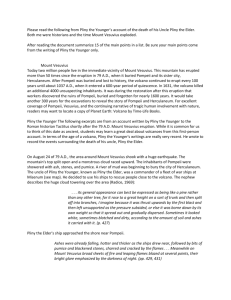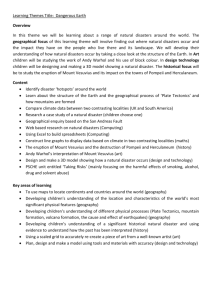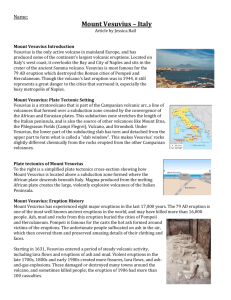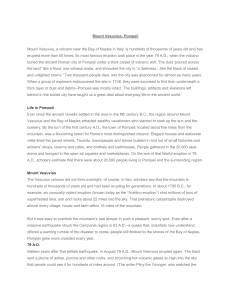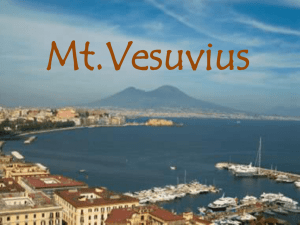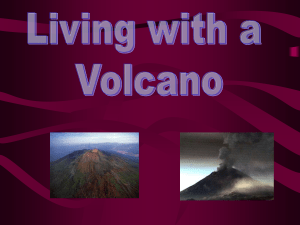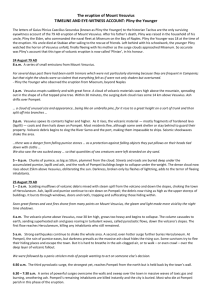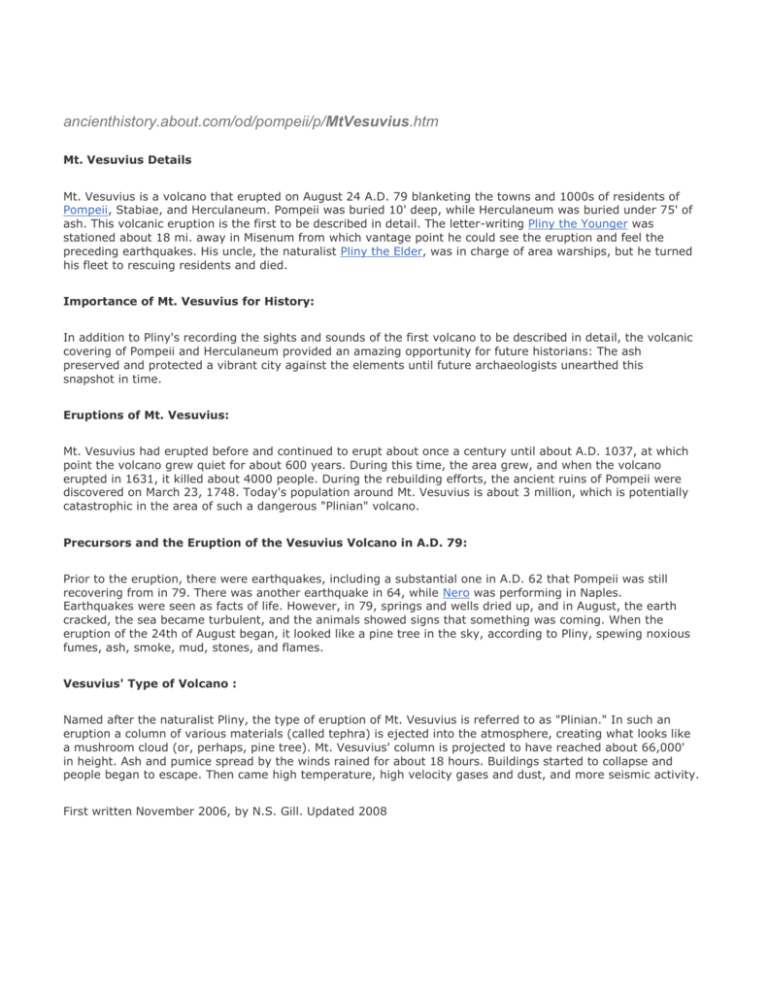
ancienthistory.about.com/od/pompeii/p/MtVesuvius.htm
Mt. Vesuvius Details
Mt. Vesuvius is a volcano that erupted on August 24 A.D. 79 blanketing the towns and 1000s of residents of
Pompeii, Stabiae, and Herculaneum. Pompeii was buried 10' deep, while Herculaneum was buried under 75' of
ash. This volcanic eruption is the first to be described in detail. The letter-writing Pliny the Younger was
stationed about 18 mi. away in Misenum from which vantage point he could see the eruption and feel the
preceding earthquakes. His uncle, the naturalist Pliny the Elder, was in charge of area warships, but he turned
his fleet to rescuing residents and died.
Importance of Mt. Vesuvius for History:
In addition to Pliny's recording the sights and sounds of the first volcano to be described in detail, the volcanic
covering of Pompeii and Herculaneum provided an amazing opportunity for future historians: The ash
preserved and protected a vibrant city against the elements until future archaeologists unearthed this
snapshot in time.
Eruptions of Mt. Vesuvius:
Mt. Vesuvius had erupted before and continued to erupt about once a century until about A.D. 1037, at which
point the volcano grew quiet for about 600 years. During this time, the area grew, and when the volcano
erupted in 1631, it killed about 4000 people. During the rebuilding efforts, the ancient ruins of Pompeii were
discovered on March 23, 1748. Today's population around Mt. Vesuvius is about 3 million, which is potentially
catastrophic in the area of such a dangerous "Plinian" volcano.
Precursors and the Eruption of the Vesuvius Volcano in A.D. 79:
Prior to the eruption, there were earthquakes, including a substantial one in A.D. 62 that Pompeii was still
recovering from in 79. There was another earthquake in 64, while Nero was performing in Naples.
Earthquakes were seen as facts of life. However, in 79, springs and wells dried up, and in August, the earth
cracked, the sea became turbulent, and the animals showed signs that something was coming. When the
eruption of the 24th of August began, it looked like a pine tree in the sky, according to Pliny, spewing noxious
fumes, ash, smoke, mud, stones, and flames.
Vesuvius' Type of Volcano :
Named after the naturalist Pliny, the type of eruption of Mt. Vesuvius is referred to as "Plinian." In such an
eruption a column of various materials (called tephra) is ejected into the atmosphere, creating what looks like
a mushroom cloud (or, perhaps, pine tree). Mt. Vesuvius' column is projected to have reached about 66,000'
in height. Ash and pumice spread by the winds rained for about 18 hours. Buildings started to collapse and
people began to escape. Then came high temperature, high velocity gases and dust, and more seismic activity.
First written November 2006, by N.S. Gill. Updated 2008
www.cotf.edu/ete/modules/volcanoes/vmtvesuvius.html
Some images © 2004 www.clipart.com
Privacy Statement and Copyright © 1997-2004 by Wheeling Jesuit University/NASA-supported Classroom of the Future. All rights
reserved.
Center for Educational Technologies, Circuit Board/Apple graphic logo, and COTF Classroom of the Future logo are registered
trademarks of Wheeling Jesuit University
The picture to the left shows Mount Vesuvius as seen from the recently
excavated ruins of Pompeii. Vesuvius is about 5 miles away. Try to imagine
huge, billowing, gray-black clouds like those at Mount St. Helens rushing
toward you at a hundred miles an hour. That is probably what the ancient
Romans (whose body casts are shown below) saw just before they were
entombed by hot ash. This mountain has erupted more than 50 times since
the eruption in 79 A.D.
The picture to the right is a satellite radar image of Mount Vesuvius and its surroundings.
Vesuvius is the purplish cone near the center of the image with a prominent summit crater
and
Photo: Courtesy Jet Propulsion Laboratory. Copyright ©
California Institute of Technology, Pasadena, CA. All rights reserved.
Based on government-sponsored research under contract NAS7-1260
The locations of Pompeii and Herculaneum may be approximated using the map shown
below
Pliny the Younger The following excerpts are from an account written by Pliny the
Younger to the Roman historian Tactitus shortly after the 79 A.D. Mount Vesuvius eruption.
While it is common for us to think of this date as ancient, students may learn a great deal
about volcanoes from this first-person account. In terms of the age of a volcano, Pliny the
Younger's writings are really very recent. He wrote to record the events surrounding the
death of his uncle, Pliny the Elder.
On August 24 of 79 A.D., the area around Mount Vesuvius shook with a huge earthquake.
The mountain's top split open and a monstrous cloud raced upward. The inhabitants of
Pompeii were showered with ash, stones, and pumice. A river of mud was beginning to bury
the city of Herculaneum. The uncle of Pliny the Younger, known as Pliny the Elder, was a
commander of a fleet of war ships at Misenum (see map). He decided to use his ships to
rescue people close to the volcano. The nephew describes the huge cloud towering over the
area (Radice, 1969):
. . . its general appearance can best be expressed as being like a pine rather than any other
tree, for it rose to a great height on a sort of trunk and then split off into branches, I imagine
because it was thrust upwards by the first blast and then left unsupported as the pressure
subsided, or else it was borne down by its own weight so that it spread out and gradually
dispersed. Sometimes it looked white, sometimes blotched and dirty, according to the
amount of soil and ashes it carried with it. (p. 427)
Pliny the Elder's ship approached the shore near Pompeii.
Ashes were already falling, hotter and thicker as the ships drew near, followed by bits of
pumice and blackened stones, charred and cracked by the flames . . . Meanwhile on Mount
Vesuvius broad sheets of fire and leaping flames blazed at several points, their bright glare
emphasized by the darkness of night. (pp. 429, 431)
But they could not land because the shore was blocked by volcanic debris, so they sailed
south and landed at Stabiae. Hoping to quiet the frightened people, the uncle asked to be
carried to the bath house. Afterward he lay down and ate. Next, hoping to
quiet the inhabitants, he went to bed. The volcano did not do likewise,
however.
By this time the courtyard giving access to his room was full of ashes mixed with pumicestones, so that its level had risen, and if he had stayed in the room any longer he would never
had got out. . . . They debated whether to stay indoors or take their chance in the open, for
the buildings were now shaking with violent shocks, and seemed to be swaying to and fro as
if they were torn from their foundations. Outside on the other hand, there was the danger of
falling pumice-stones, even though these were light and porous. . . . As a protection against
falling objects they put pillows on their heads tied down with cloths. (pp. 431, 433)
Finally, the uncle decided to leave. The level of ash and pumice-stone had risen to the point
that a hasty departure seemed the best option.
. . . the flames and smell of sulphur which gave warning of the approaching fire drove the
others to take flight and roused him to stand up . . . then [he] suddenly collapsed, I imagine
because the dense fumes choked his breathing by blocking his windpipe which was
constitutionally weak and narrow and often inflamed . . . his body was found intact and
uninjured, still fully clothed and looking more like sleep than death. (p. 433)
Later, Pliny the Younger and his mother leave Misenam to escape from the approaching
volcanic conflagration. They travel across country to avoid being trampled by the crowds of
people on the road.
We also saw the sea sucked away and apparently forced back by the earthquake: at any rate
it receded from the shore so that quantities of sea creatures were left stranded on dry sand.
On the landward side a fearful black cloud was rent by forked and quivering bursts of flame,
and parted to reveal great tongues of fire, like flashes of lightning magnified in size. . . . We
had scarcely sat down to rest when darkness fell, not the dark of a moonless or cloudy night,
but as if the lamp had been put out in a closed room. You could hear the shrieks of women,
the wailing of infants, and the shouting of men; some were calling their parents, others their
children or their wives, trying to recognize them by their voices. People bewailed their own
fate or that of their relatives, and there were some who prayed for death in their terror of
dying. (pp. 443, 445)
People in 79 A.D., like Harry Truman in 1980, may have thought they "knew the mountain."
Photo: Courtesy of Dr. J.A. Botti.
Excavaters found that much of what Pompeii looked like in 79 A.D. had been preserved by
the ash that had fallen. A bakery oven contained loaves of bread nearly 2000 years old!
Victims of Vesuvius were immortalized when their decomposed bodies left cavities in the
hardened ash. The cavities were filled with plaster to recreate victims much as they looked at
the time of their death. Photo: Courtesy of Dr. J.A. Botti.
For more information about Pompeii, you can visit the Pompeii Forum Project.
[ Home ] [ Teacher Pages ] [ Modules & Activities ]
geology.com › Volcanoes
Facts About Mount Vesuvius
Location:
West coast of Italy
Coordinates:
40°49′ N
Elevation:
1281meters (4000 feet)
Volcano Type:
Complex
Last Eruption:
1944
Nearby Volcanoes:
Etna Stromboli
14°26′ E
Mount Vesuvius - Italy
Article by Jessica Ball
Mount Vesuvius Introduction
Vesuvius is the only active volcano in mainland Europe, and has produced some of the continent’s largest volcanic eruptions. Located on Ital
west coast, it overlooks the Bay and City of Naples and sits in the crater of the ancient Somma volcano. Vesuvius is most famous for the 79 A
eruption which destroyed the Roman cities of Pompeii and Herculaneum. Though the volcano’s last eruption was in 1944, it still represents a
danger to the cities that surround it, especially the busy metropolis of Naples.
Map: Where is Vesuvius?
Map showing the location of Mount Vesuvius on the west coast of Italy.
Map by Geology.com and MapResources. Nearby Volcanoes: Etna
Stromboli
Mount Vesuvius: Plate Tectonic Setting
Vesuvius is part of the Campanian volcanic arc, a line of volcanoes that formed over a subduction zone created by the convergence of the A
and Eurasian plates. This subduction zone stretches the length of the Italian peninsula, and is also the source of other volcanoes like Mount
the Phlegraean Fields (Campi Flegrei), Vulcano, and Stromboli. Under Vesuvius, the lower part of the subducting slab has torn and detached
the upper part to form what is called a "slab window". This makes Vesuvius’ rocks slightly different chemically from the rocks erupted from the
other Campanian volcanoes.
Simplified plate tectonics cross section (A to B)
Simplified plate tectonics cross-section showing how Mount Vesuvius is
located above a subduction zone formed where the African plate
descends beneath Italy. Magma produced from the melting African plate
creates the large, violently explosive volcanoes of the Italian Peninsula.
Mount Vesuvius: Eruption History
Mount Vesuvius has experienced eight major eruptions in the last 17,000 years. The 79 AD eruption is one of the most well known ancient
eruptions in the world, and may have killed more than 16,000 people. Ash, mud and rocks from this eruption buried the cities of Pompeii and
Herculaneum. Pompeii is famous for the casts the hot ash formed around victims of the eruptions. The unfortunate people suffocated on ash
air, which then covered them and preserved amazing details of their clothing and faces.
Starting in 1631, Vesuvius entered a period of steady volcanic activity, including lava flows and eruptions of ash and mud. Violent eruptions i
late 1700s, 1800s and early 1900s created more fissures, lava flows, and ash-and-gas explosions. These damaged or destroyed many towns
around the volcano, and sometimes killed people; the eruption of 1906 had more than 100 casualties. The most recent eruption was in 1944
World War II. It caused major problems for the newly-arrived Allied forces in Italy when ash and rocks from the eruption destroyed planes and
forced evacuations at a nearby airbase.

